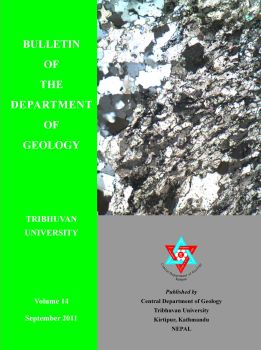Petrography of fine aggregates from Kaligandaki River, western Nepal: implication for assessment of deleterious constituents
DOI:
https://doi.org/10.3126/bdg.v14i0.5436Keywords:
Petrography, kaligandaki river, petrography analysisAbstract
Seven fine aggregate samples from test pits driven at the river banks of the Kaligandaki River and banks of the contributingstreams around Kokethanti-Chhyo Bagar area were petrographically analysed as these will be used for concrete aggregates. Theaggregates had median grains size of 0.45-1.00 mm and were well graded. They were dominantly composed of carbonate rockfragments and the total QFL modes being Q14.81–28.87F0.63–4.58L66.55–84.15. All the samples were classified as medium-grainedcalc-lithic sands. Quartz grains were dominantly megaquartz. Some chert grains and few quartz grains occurring in siliceouslimestones were of microquartz.Considering deletereous constituents, the sample T1 had chert fragments. The sample T2 had high amount of micas suggestingits low workability. Silt/clay-grade size fraction was the deletereous material to all the samples and this fraction should be removedduring processing. The samples T2, T6 and T7 showed greater preferability among the samples as these had lower amount ofunsound rock fragments such as carbonaceous schists/phyllite, and other deletereous materials.
DOI: http://dx.doi.org/10.3126/bdg.v14i0.5436
Bulletin of the Department of Geology Vol.14 2011, pp. 29-34
Downloads
Downloads
How to Cite
Issue
Section
License
© Central Department of Geology, Tribhuvan University, Nepal

